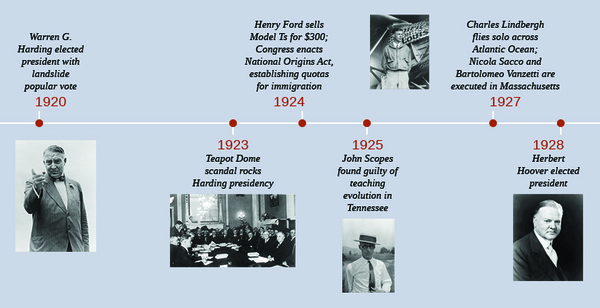| << Chapter < Page | Chapter >> Page > |

In the 1920s, prosperity manifested itself in many forms, most notably in advancements in entertainment and technology that led to new patterns of leisure and consumption. Movies and sports became increasingly popular and buying on credit or “carrying” the debt allowed for the sale of more consumer goods and put automobiles within reach of average Americans. Advertising became a central institution in this new consumer economy, and commercial radio and magazines turned athletes and actors into national icons.
The increased prosperity of the 1920s gave many Americans more disposable income to spend on entertainment. As the popularity of “moving pictures” grew in the early part of the decade, “movie palaces,” capable of seating thousands, sprang up in major cities. A ticket for a double feature and a live show cost twenty-five cents; for a quarter, Americans could escape from their problems and lose themselves in another era or world. People of all ages attended the movies with far more regularity than today, often going more than once per week. By the end of the decade, weekly movie attendance swelled to ninety million people.
The silent movies of the early 1920s gave rise to the first generation of movie stars. Rudolph Valentino, the lothario with the bedroom eyes, and Clara Bow, the “It Girl” with sex appeal, filled the imagination of millions of American moviegoers. However, no star captured the attention of the American viewing public more than Charlie Chaplin. This sad-eyed tramp with a moustache, baggy pants, and a cane was the top box office attraction of his time ( [link] ).

In 1927, the world of the silent movie began to wane with the New York release of the first “talkie”: The Jazz Singer . The plot of this film, which starred Al Jolson, told a distinctively American story of the 1920s. It follows the life of a Jewish man from his boyhood days of being groomed to be the cantor at the local synagogue to his life as a famous and “Americanized” jazz singer. Both the story and the new sound technology used to present it were popular with audiences around the country. It quickly became a huge hit for Warner Brothers, one of the “big five” motion picture studios in Hollywood along with Twentieth Century Fox, RKO Pictures, Paramount Pictures, and Metro-Goldwyn-Mayer.
Southern California in the 1920s, however, had only recently become the center of the American film industry. Film production was originally based in and around New York, where Thomas Edison first debuted the kinetoscope in 1893. But in the 1910s, as major filmmakers like D. W. Griffith looked to escape the cost of Edison’s patents on camera equipment, this began to change. When Griffith filmed In Old California (1910), the first movie ever shot in Hollywood , California, the small town north of Los Angeles was little more than a village. As moviemakers flocked to southern California, not least because of its favorable climate and predictable sunshine, Hollywood swelled with moviemaking activity. By the 1920s, the once-sleepy village was home to a majorly profitable innovative industry in the United States.

Notification Switch
Would you like to follow the 'U.s. history' conversation and receive update notifications?